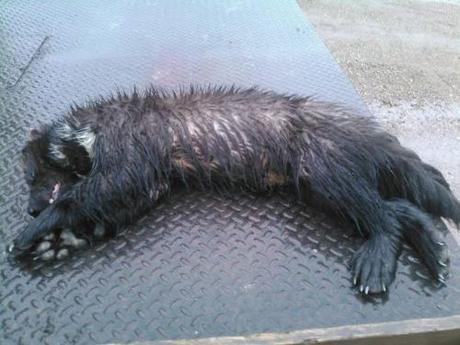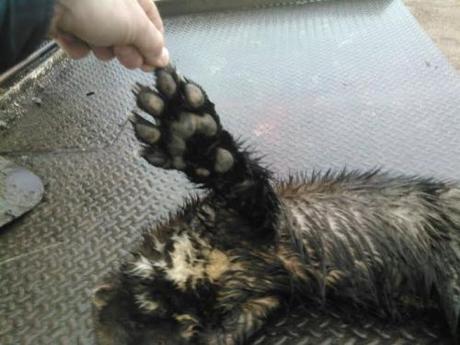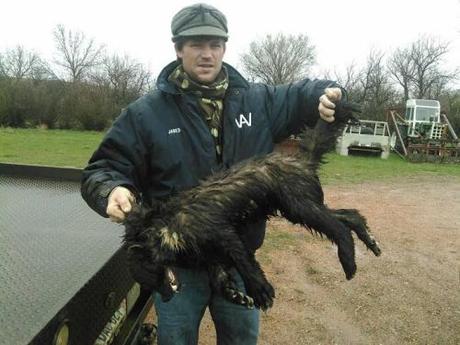A wolverine was apparently killed in Western North Dakota on Monday, April 25. The wolverine was killed near Alexander, North Dakota, probably during the daylight hours but at an unknown time. It is not known how the animal was killed, but no doubt it was shot dead with some sort of longarm weapon. The animal was killed by a rancher when it was harassing pairs of calves in a field. The rancher thought it was going to kill one of his calves, so he shot it.
After the rancher killed the animal, he contacted the North Dakota Game and Fish Department. Biologists from the department examined the animal and determined that it was indeed a wolverine. The kept the wolverine and took it away to an unknown location. Apparently there has not yet been any news reports of this incident. This report will be the first report of the incident and the photos associated with it to appear in the mainstream online media.
There have been a number of unverified sightings of wolverines in North Dakota in the past two decades. They are listed in my report, Wolverines in the Upper Midwest, available here. This is the most detailed report on wolverines in this region on the Internet or possibly anywhere for that matter. Be sure to check it out if you are interested in the subject. It has lots of great photos of the areas in which wolverines were spotted and the general terrain of the region.
It is an open question when the last verified wolverine was taken in North Dakota, as the US Fish and Wildlife Service apparently maintains that there has never been one good record of a wolverine from North Dakota. However, there are 36 known records of wolverines taken in North Dakota, but 35 of these, from a variety of locales, are from the journal of a single fur trapper, William Henry.
The USFWS regards these records as possibly spurious since they nearly all came from a single person and it is uncertain whether these are records of locales where wolverines were actually taken or whether these were instead collection points for specimens from the fur trapping trade. Wolverine biologists feel that according to the known habitat associations of the wolverine in the US, it is not possible that North Dakota ever housed a population of established wolverines or that North Dakota was ever suitable wolverine habitat.
The question here centers around the question of what one means by established population. To wildlife biologists, established population appears to mean breeding population and these people argue that the upper great plains does not offer suitable habitat for breeding wolverines, apparently due to the lack of snow cover into the Late Spring. Nevertheless, I am personally uncertain whether snow lasts into the Late Spring in North Dakota. Perhaps it does.
However, experts also argue that wolverines cannot live in this region because summer temperatures are too high. Nevertheless, the high number of records from North Dakota indicates that wolverines probably were able to live here year round despite high summer temperatures. In addition, a wolverine recently lived for 5-10 years around the area of Ubly, Michigan where summer temperatures may well be as high as those in North Dakota. Based on this data, perhaps the Summer Temperature Theory about wolverines is wrong.
Based on the number of reports coming in of wolverines not only from North Dakota but also from elsewhere in the Upper Midwest and the long historical record of sightings in this area from the 19th Century, it seems logical to posit that the Great Plains may possibly be wolverine habitat now and possibly were pre-contact and even for a period of time after contact before they were extirpated by the fur trade.
Although the prairie seems to be an odd place to have wolverines, when you think about the great herds of buffalo that used to roam here, perhaps it is not so strange after all. My post linked above has a number of photos of prairie terrain and habitat along with some theorizing on how and why the prairies may have been good habitat for wolverines pre-contact and may be good habitat today.
Wolverines were last taken in Indiana in 1852, Michigan in 1860, Wisconsin in 1870, and Minnesota in 1899. Another wolverine was killed recently in Minnesota in 1965.
The date of Henry’s journals is not known, nor is it known precisely who Henry was. However, there was a great deal of fur trapping being done in the region between 1809 and 1834. The two major fur companies trapping in the area closed in 1830 and 1834, suggesting that the area may have been trapped out by the early to mid-1830’s. Henry’s journals may well refer to this time period, but this is not known for certain. Therefore, the last record of a wolverine from North Dakota is unknown. Records exist, but I am not able to access them. Perhaps an enterprising person can dig up these records to add to this breaking story.
Photos of the wolverine are available below. Based on the photographs, it does indeed appear to be a wolverine.

Side view of the wolverine killed just recently in North Dakota. Note the huge padded paws and the massive claws.

Another side view with an emphasis on the head and front of the animal. Note the black and white dual colored hair color, the shape of the small ears, the elongated snout, the big fangs and of course the huge padded paws. The pads and claws on the feet of a badger look something like this, but on the wolverine, these characteristics may be more accentuated.

Yet another photo of the wolverine, this time with an emphasis on the paws and the claws.

Wolverine shot in North Dakota on April 25. The man holding the animal is possibly the one who shot and killed the animal.
References
- Aubry, K. B., K. S. McKelvey, and J. P. Copeland. 2007. Geographic Distribution and Broadscale Habitat Relations of the Wolverine in the Contiguous United States. Journal of Wildlife Management 71: 2147-2158.
Copeland, J. P. and Whitman, J. S. 2003. “Wolverine,” pp. 672-682, in Wild Mammals of North America, Biology, Management, and Economics. G. A. Feldhamer, B. C. Thompson, and J. A. Chapman, eds. Johns Hopkins University Press.
Whitaker, John O. and Hamilton, William John. 1998. Mammals of the Eastern United States, p. 551. Ithaca, NY: Cornell University Press.
